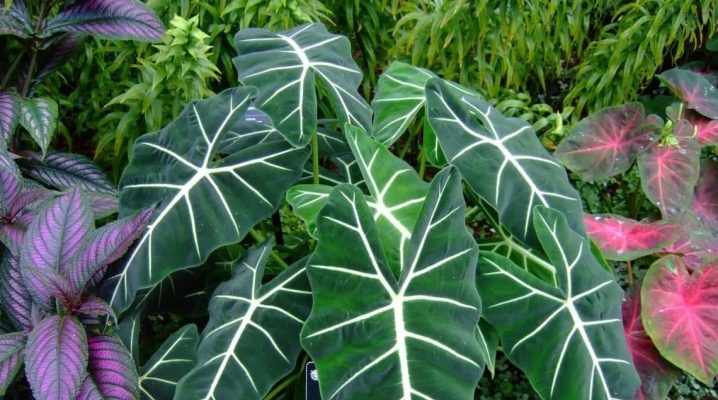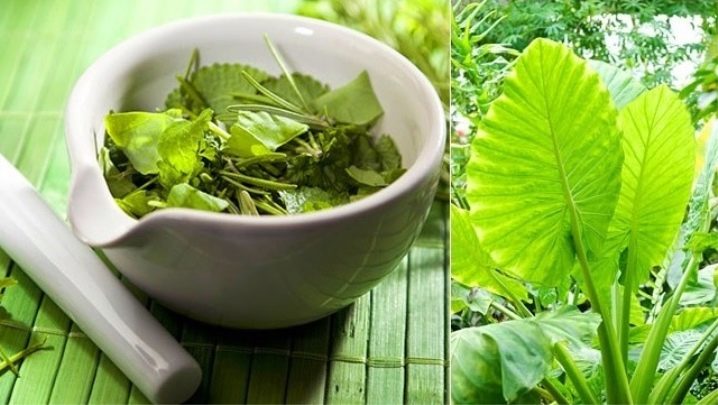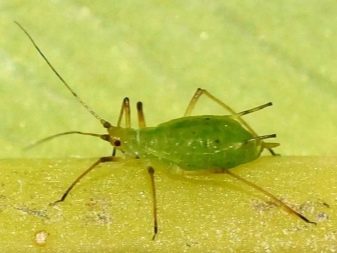Alokazia "Polly": features and rules of care

Mysterious and incompletely studied tropical plants brought from distant countries are gaining more and more popularity every year. Florists recommend using them for the decoration of residential premises, offices and social facilities.
One of the most popular tropical plants is the Polly Alocasia. This flower with large and bright leaves not only decorates the space around itself, but also purifies the air and normalizes the emotional situation in the apartment, removes negativity and negative emotions. Before purchasing alocasia, novice gardeners should carefully study its properties and care features.




Description
Alokazia "Polly" - an evergreen hybrid plant that belongs to the Aroid family. The homeland of the flower is the Malay Archipelago and Indochina. The maximum height of home alocasia, which can be either a shrub or a small tree, reaches 55 cm.
The size of the dark green leaf plate can reach 35 cm and is heart-shaped with carved edges. A characteristic feature is the metallic shade of the leaves and the presence of pronounced cream veins on their surface. The maximum number of leaves on one flower is 11 pcs.


Botanists recommend paying attention to the presence of water stomata in alocasia, which are located above or below the epidermis and are designed to remove excess liquid from the plant, as well as for gas exchange with the environment. Novice growers often mistake water drops for dew.
The indoor pet has a powerful and thick vertical trunk. The root system is presented in the form of a compact tuber. At home, a flower rarely forms inflorescences, even in the most comfortable conditions. Only in special nurseries can you see white or pink flowers on adult plants that have a rich smell. After the withering of the inflorescences, fruits with seeds are formed on the plant.


Before purchasing this flower, it is necessary to take into account the fact that its juice is poisonous, due to the presence of cyanides and mercury chlorides in its composition. These elements can cause burns and swelling.
When caring for a green pet, it is necessary to avoid contact with a hazardous substance on the skin and mucous membranes. Florists do not recommend keeping alocasia in children's rooms at home.
Due to the presence of phytocides, the flower not only cleans the air in the living room from harmful and toxic substances, but also ionizes and disinfects it. The plant has a detrimental effect on pathogens of viral diseases, on staphylococcus, streptococcus and intestinal infection.

Beneficial features
Alokazia "Polly" is not only an ornamental plant, but also a medicinal one. Its chemical composition consists of quercetin, lycuraside, hyperoside, alkaloids and coumarin.
Medicinal preparations based on this plant are used as wound healing and disinfectants, and they also have the following positive effect on the body:
- strengthening the immune system;
- reduction of edema and inflammation;
- reduction of toothache and neurological pain;
- elimination of itching;
- slowing down the development of cancerous tumors;
- improving the functioning of the venous system;
- reduction of spasms;
- restoration of the mucous membrane of the respiratory tract.

Specialists in the field of traditional medicine use medicinal formulations for the following pathologies:
- diseases of the digestive system;
- inflammation of the joints and the musculoskeletal system;
- skin rashes;
- disruption of the endocrine system.
Doctors categorically prohibit taking medicinal formulations for women during the period of gestation and breastfeeding and for children under 16 years of age.

Growing and care
Despite the fact that the natural habitat of the flower is the tropics, this plant is unpretentious and care for it will not cause difficulties even for inexperienced growers.
In the summer, experts recommend watering alocasia 3 times a week. To increase the humidity of the air, you should install flowerpots with water around the flower and constantly moisten the pebbles in the pallet. In winter, the amount of watering is reduced to 2 times a week. For irrigation, it is necessary to use only settled water at room temperature, which contains a minimum amount of salts of heavy metals, chlorine and lime.
Regular spraying of leaf plates with a spray bottle will significantly improve the condition of the flower in the summer, as well as during the heating season.... This procedure can be replaced by regularly wiping the leaves with a damp sponge. To enrich the root system with oxygen, it is necessary to regularly loosen the soil.

The most comfortable level of temperature in summer is + 26 degrees. In winter, the temperature in the room should not drop below + 18 degrees. The plant has a negative attitude to sudden temperature changes and strong air currents. Experienced florists recommend placing flower pots on window sills with windows facing east or west.
Additional nutrients will have a beneficial effect on the growth and development of the flower. In the summer and in the spring, it is necessary to use nitrogenous and potassium mineral fertilizers. In autumn and winter, the plant needs phosphorus supplements. You need to feed the flower no more than once every 30 days.

Experts recommend transplant young plants annually, and older flowers need to change the planting container every 3 years. Due to the presence of a fragile root system, the flower should be moved using the transshipment method. To prevent root deformation, it is necessary to leave the old clod of earth intact.
To plant a flower, you need to choose light and nutritious soil mixtures, which should consist of leafy soil, humus, peat, sand and charcoal. Experienced gardeners recommend giving preference to purchased earthy soil for orchids for planting, to which you need to add a small amount of peat and garden soil. A prerequisite for planting is the presence of drainage material at the bottom of the flower pot.


Failure to follow the rules of care can provoke the following problems:
- tarnishing of the leaf plate - low level of illumination;
- dark spots on leaves and trunks, as well as their drying - direct sunlight hitting platinum sheets;
- falling and drying of foliage - development of putrefactive processes of the root system, excessive watering;
- slow formation of new shoots and leaves - insufficient application of nitrogen fertilizers;
- wilting of leaves and changes in their structure - non-observance of the soil moisture regime;
- falling foliage and buds during the flowering period - lack of nutrients and soil depletion.



Reproduction
In order to get a new plant, you can use one of two propagation methods.
Dividing tubers
A simple breeding method that can be used in the spring during plant transplantation. For its implementation, it is necessary to divide the onion into several parts with a sharp and sterile cutting tool and put the resulting pieces in a small technical container with a peat nutrient mixture.
To accelerate and germinate planting material, it is necessary to cover the pot with cling film, which will help create the necessary greenhouse effect.
Planting containers should be placed in a warm and well-lit area. Inexperienced growers should remember to ventilate the pots and moisten the soil. Only after the appearance of the first young leaves can the protective shelter be removed. Florists recommend picking off the first new leaves.


Cuttings
Getting a new plant by rooting cuttings is a quick and easy way to propagate. The mechanism of this procedure consists in rooting the cut leaf plates in water, to which a stimulant for the growth of the root system has been added. Once the roots have formed, the shoots can be planted in small containers with a light and nutritious potting mix.
When separating poisonous tubers, it is imperative to use rubber gloves, and rinse the working tool immediately after work under plenty of running water.
Due to the fact that alocasia "Polly" is a hybrid plant, experts do not recommend using the seed method of reproduction. Using this method, it is impossible to get a new plant that would inherit all the varietal characteristics. In specialized laboratories and nurseries, experienced breeders often use cloning of this variety.

Diseases and pests
Like any other plant, alocasia is susceptible to a number of diseases and the action of harmful insects. Biologists identify several of the most common types of dangerous pests:
- spider mite;
- shield;
- whitefly;
- aphid.




The presence of white spots and thin filaments of cobwebs on the plant indicates the presence of a spider mite. To destroy it, you need to treat the flower with special chemicals.
The appearance of a scaly scale can be identified by the presence of brown tubercles on the leaves. In order to rid the alocasia of the parasite, it is necessary to wash the leaf plates with soapy water. If this procedure does not bring the desired result, experts recommend using fungicides.
To determine the presence of whitefly will help the silvery pad, which the insect leaves on the entire surface of the flower. Only chemical preparations will help get rid of the insect.
Aphid colonies on a plant can be noticed even by novice growers. Small pests are located on the underside of the leaf plates and suck the juice out of them. Prolonged presence of pests can provoke deformation of young plants. In order to remove insects, you need to wash the leaves with soapy water, to which vegetable oil is added. In the presence of numerous colonies of aphids, experts recommend using insecticides.
Novice growers need to know that only a healthy and strong plant has a low level of susceptibility to diseases and will be able to recover from past diseases and the action of pests.
How to properly care for Polly alocasia, see below.
























The comment was sent successfully.